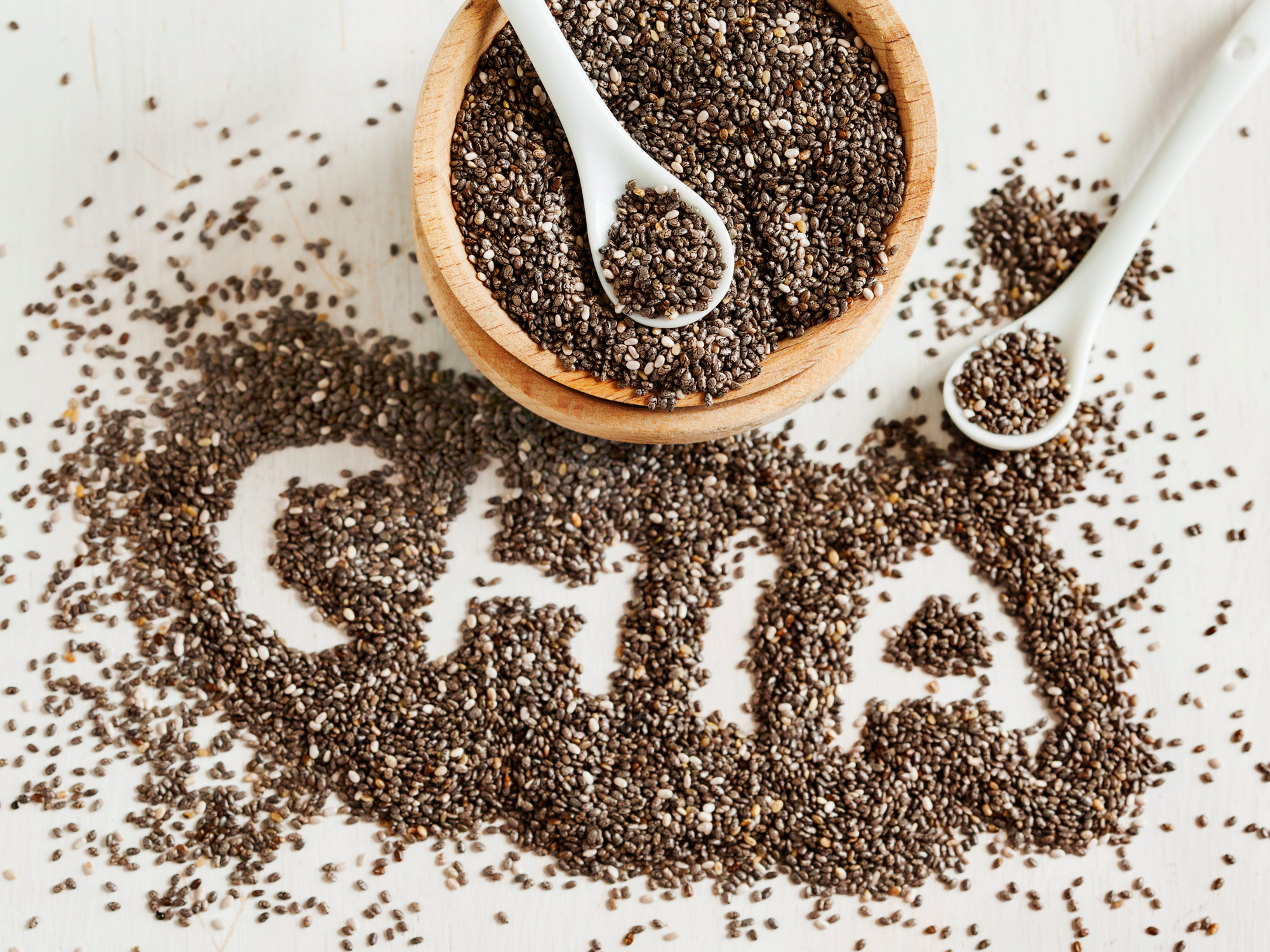Get Easy Health Digest™ in your inbox and don’t miss a thing when you subscribe today. Plus, get the free bonus report, Mother Nature’s Tips, Tricks and Remedies for Cholesterol, Blood Pressure & Blood Sugar as my way of saying welcome to the community!
Chia: The tiny superfood that’s a BIG deal

Would you like to know how to lower blood pressure, lower heart attack and stroke risk, lower inflammation in the body, restore gut health, balance the immune system, and increase fiber with a single whole food?
Then you need to be introduced to the chia seed — a tiny gluten-free, plant-based whole food that will do all that and more…
The chia seed isn’t much to look at, but it packs an incredible amount of nutrition into a tiny package. The chia seed stands as one of the most nutrient-dense foods in existence, on both the macronutrient and micronutrient level. The Aztecs considered it “more valuable than gold.”
Why does chia deserve a place in your daily nutrition regimen?
Just a 2 tbsp. (1 oz.) serving of chia seeds offers:
- Five times the omega-3 content of a 1/4 cup serving of walnuts
- Twice the iron and magnesium of a cup of spinach
- As much calcium as a half-cup of milk
- As much potassium as a third of a banana
- More than twice the fiber (soluble and insoluble) than a cup of oatmeal
- Soft seed coat so you can consume the whole seed without milling
Chia is also a potent antioxidant source on par with blueberries and other blue-red fruits with impressive levels of kaempferol, chlorogenic acid, caffeic acid and quercetin — a flavonoid with known anti-inflammatory and antiviral properties.
Chia’s nutrition profile
Chia seed’s nutritional profile is undeniably broad and impressive. A standard 1 oz. serving (just about 2 tbsp or 28 g) of chia seeds contain:
- Calories: 137
- Protein: 4 grams
- Fat: 8 grams (heart-healthy and brain-protective omega-3s)
- Carbs: 12 grams (11 of which are FIBER!)
- Fiber: 11 grams (of your clear goal of 50 grams/day)
Chia’s protein contains all nine essential amino acids and a host of trace minerals and micronutrients. This includes 18 percent of your daily value (DV) of calcium, 27 percent DV of phosphorus, and 30 percent DV of manganese.
Those amazing essential fatty acids
The ratio of Omega-6 essential fatty acids to omega-3 fatty acids in chia is 1620:4915 (a 1:3.03 Ratio). Compare this to the Standard American Diet (S.A.D.) which is about 25:1 (Omega6:3). That is 75 times more anti-inflammatory Omega-3’s than inflammatory Omega-6’s! This is a crucial whole food that can assist in the process of reversing inflammation in the body — to protect your heart and brain health, and guard against diabetes, obesity, arthritis and cancer.
Plant-based Omega 3 sources (like Chia and Flax) provide mainly short-chain fat alpha-linoleic acid (ALA), which the human body inefficiently converts to more biologically active long-chain fats (like EPA and DHA — mainly derived from fish).
However, a recent study found that after seven weeks of taking 25 grams (about 2 Tbsp.) of milled chia daily, female test subjects showed significantly higher levels of plasma EPA (up to 20 percent), not just ALA. The health benefits associated with ALA consumption include cardiovascular effects, neuro-protection, a counter to the inflammation response, and benefits against autoimmune disease.
They are rich in phosphorous, manganese, calcium and potassium, all of which support healthy heart and muscle function and allow support for endurance events. One study shows quercetin also “has important implications for enhancement of athletic and military performance,” after it was shown to increase both VO2 max and endurance capacity in human subjects.
One of its best athletic benefits is the seed’s outer husk is hydrophilic, meaning it draws in fluid. When mixed in water, chia seeds can absorb 10 times their weight in fluid, helping to retain hydration between work-outs, or a great way to pre-hydrate and prolong hydration during intense training.
Chia’s amazing health benefits
- Reduces inflammation and autoimmune diseases
- Protects the Heart and Liver during weight loss in the obese
- Increases Omega-3’s ALA and EPA – up to 20 percent conversion of ALA to EPA
- Restores and supports immune system balance
- Cardio-protective in women
- Contains powerful anti-oxidants
- Lowers cholesterol and blood pressure
- Lessens joint pain
- Weight loss
- Diabetics have found reduced insulin spikes
- More energy later in the day
- Increased fingernail growth
- Shinier, softer hair
Easy ways to enjoy chia seeds
Add 1 ounce of chia seeds (2 Tbsp.) to your:
- Smoothie — add seeds or powders after it’s in your cup
- Pancakes — with cloves, cinnamon and nutmeg
- Salads (on top – makes vitamin A, E, D, and K from your greens absorbable)
- Whole grain muffins
- Yogurt parfait — stir it into plain or Greek with fruit, nuts or protein powder
- Oatmeal — with cinnamon and nutmeg
- Egg replacement — replace 1 egg by adding 1 Tbsp. chia seeds to 3 Tbsp water for 15 min, then stir.
Sources:
-
http://nutritiondata.self.com/facts/nut-and-seed-products/3061/2
-
http://lyush.ntyxc.servertrust.com/v/vspfiles/bps_pdfs/nanomega/04ALAoverlooked.pdf
-
Davis JM1, Carlstedt CJ, Chen S, Carmichael MD, Murphy EA. The dietary flavonoid quercetin increases VO(2max) and endurance capacity. Int J Sport Nutr Exerc Metab. 2010 Feb;20(1):56-62. https://www.ncbi.nlm.nih.gov/pubmed/20190352
-
Simopoulos, A.P., 2002. Omega-3 fatty acids in inflammation and autoimmune diseases. Journal of the American College of Nutrition, 21(6), pp.495-505. http://www.tandfonline.com/doi/abs/10.1080/07315724.2002.10719248
-
H. Poudyal, S. K. Panchal, J. Waanders, L. Ward, and L. Brown, “Lipid redistribution by α-linolenic acid-rich chia seed inhibits stearoyl-CoA desaturase-1 and induces cardiac and hepatic protection in diet-induced obese rats,” Journal of Nutritional Biochemistry, vol. 23, no. 2, pp. 153–162, 2012
-
Jin, F., Nieman, D.C., Sha, W., Xie, G., Qiu, Y. and Jia, W., 2012. Supplementation of milled chia seeds increases plasma ALA and EPA in postmenopausal women. Plant Foods For Human Nutrition, 67(2), pp.105-110 http://link.springer.com/article/10.1007/s11130-012-0286-0
-
I. Fernandez, S. M. Vidueiros, R. Ayerza, W. Coates, and A. Pallaro. Impact of chia (Salvia hispanica L.) on the immune system: preliminary study,” Proceedings of the Nutrition Society, vol. 67, article E12, 2008 https://www.cambridge.org/core/journals/proceedings-of-the-nutrition-society/article/impact-of-chia-salvia-hispanica-l-on-the-immune-system-preliminary-study/9FB7DF18C989B3FF48E84801E79D6BFC
-
M. S. Vedtofte, M. U. Jakobsen, L. Lauritzen, et al., “Dietary alpha linoleic acid, linoleic acid and n-3 long-chain PUFA and risk of ischemic heart disease,” The American Journal of Clinical Nutrition., vol. 94, pp. 1097–1103, 2011 http://ajcn.nutrition.org/content/94/4/1097












